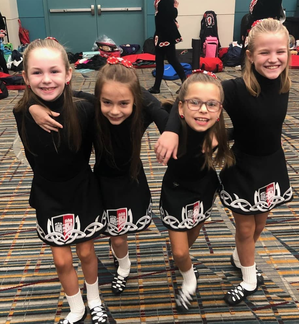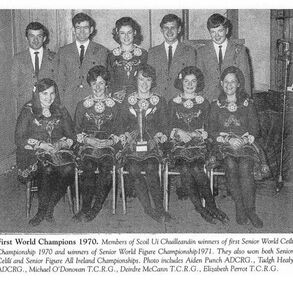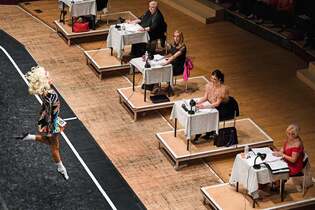 SRL dancers in their school skirts at the 2019 New England Oireachtas SRL dancers in their school skirts at the 2019 New England Oireachtas Levels and Competitions, Part 3 Many of our parents and dancers here at SRL are fully aware of all the ins and outs of Irish dance, and this post isn’t really for them (unless they’ve always been a little fuzzy on some of it—we won’t tell! It’s complicated!) This post is for our up and coming dancers who are excited about competing more regularly. If you’re a Beginner, still learning the ropes, or checking out our website for the first time, check out the six previous posts in the series to catch you up to the present in Irish dance’s history! Regional Oireachtas to Worlds Irish dance’s prevalence these days isn’t simply a case of respect for the intricate footwork, perfect balance, and incredible stamina and grace it takes to make an Irish dancer, it’s a type of cultural exchange that expands the diaspora of the Irish people. Whether you’re of Irish heritage or not, participating in or watching Irish dance brings you a little closer to a country with a complex and rich history. It’s no surprise that the CLRG (the main governing body of Irish dance, based in Ireland) now have records to indicate “that Irish dancing is practiced in countries as far afield as Japan, Brazil, Argentina, South Africa and at an ever-growing rate in Eastern Europe.” Not to mention North America! In our previous two installments, we discussed the foundation of competitive Irish dance: the role of feiseanna (pronounced fesh-anna, the plural of feis i.e. fesh) and the different types of dances performed at these festival competitions (with corresponding music and at varying levels as your technique and skill develop.) But feiseanna are only the local level of the competitive Irish dance circuit. The next step? Time to move up to an Oireachtas competition! (At your teachers’ and parents’ discretion, of course!) The term “Oireachtas” (pronounced o-rock-tus, but say it quickly!) denotes a regional competition (as opposed to a local feis) that can be as broad as a whole section of the country, though the way your day goes will look much like a feis. Fun fact: as the word oireachtas roughly translates to “gathering” or “assembly,” it’s also used as the title of the parliament of the Republic of Ireland, but anyone in the Irish dance world will know what you mean! Oireachtaisi (the plural!) all over the world may have once been more or less very large feiseanna, but these days the annual competitions are held as qualifiers for the World Championship competitions.  The first World Champs in 1970! The first World Champs in 1970! In North America, there are seven regional oireachtaisi competitions each year (held in and around November) put on by the regional branches of the Irish Dance Teachers’ Association of North America (IDTANA.) Each regional (ours is New England!) oireachtas holds a main championship, which SRL dancers are able to start competing in once they reach the Preliminary Championship level. Somewhere in between Oireachtas and Worlds are national competitions (North America’s is usually in July) that are generally secondary qualifiers for Worlds and open only to the highest level of SRL competitor: Open Championship dancers (see more about the levels in last week’s post!) Depending on the size, these competitions can last several days. Each region also holds team competitions, where dancers compete together in groups of 4, 8, or 16 in traditional céilí dances. SRL dancers are invited to the team program when they reach Beginner II and have shown dedication to their dancing through consistent attendance and regular home practice. The céilí dances are standardized by CLRG and are a great exercise in dancing in unison while keeping impeccable technique, all by depicting beautiful movement patterns with those on their team! Regional Oireachtaisi may also hold a subsidiary competition for up and coming dancers to gain experience on the bigger stage. In New England, we hold a traditional set competition where dancers prepare one of the seven standardized traditional set dances to perform for three adjudicators. Once they complete this hard shoe choreography (that’s been passed down generation to generation!), the dancers receive a rank or placement based on rhythm, timing, technique, and posture. At SRL, dancers in the Beginner II Hard Shoe classes are invited once they’ve mastered the set dance “St. Patrick’s Day.”  A competitor and adjudicators at 2018’s Worlds—slight changes in 48 years! A competitor and adjudicators at 2018’s Worlds—slight changes in 48 years! 2020 held a number of unique challenges and disappointments, and none more devastating in the realm of Irish dance as the cancellation of the Oireachtas Rince na Cruinne’s (or the World Irish Dancing Championships’) 50th anniversary this past year. While there’s technically no less than six other organizations that call their competition “Worlds,” the Oireachtas Rince na Cruinne overseen by the CLRG is the oldest running (fingers crossed for 2021!) and often referred to as the “Olympics of Irish Dance.” It’s considered by many to be the most prestigious competition available for Irish dancers, and in its early days (1975) was won by no other than Michael Flatley (yes, the “Lord of the Dance,” aka the first name the average person knows in connection with Irish dance and the first American to win!) The first Worlds took place in 1970 (see the pic above!) in Dublin’s tiny Coláiste Mhuire theater in Parnell Square and to this day is usually held over Easter week. The competition remained in Ireland (though the towns and cities rotated) until 2009, when America hosted the competition in Philadelphia. (Though it has now been held in the other countries where the highest concentration of Irish dancers live: Northern Ireland, Scotland, Great Britain, and Canada.) And while Worlds may have started small, 2019’s event (hosted in Greensboro, NC) boasted approximately 5,000 competitors and about 20,000 supporters. When you think of the fact that upon its founding in 1932, the CLRG counted only 32 teachers and 27 adjudicators (aka judges,) it’s easy to see that Irish dance really has become a worldwide phenomenon! While this “olympic” event can be, in many ways, the pinnacle of an Irish dancer’s career (just qualifying is a huge achievement!) there’s many avenues for dancers to keep their love of Irish dance alive after they retire from the competitive circuit. Beyond the numerous professional companies that tour around the world, helping Irish dance, music, and culture reach innumerable people, many Irish dancers become Irish dancer teachers (just look at our staff!) or open their own studios (like Miss Courtney!) There’s also degrees (both BA and MA) in Irish Dance Studies (once again—Miss Courtney’s a great example,) though many dancers pivot into dance-adjacent professions: nutrition, physical therapy, arts administration or fundraising (to name only a few)…it doesn’t have to become a hobby in a dancer’s adult life! This post is part of a series. Read Part 1 of Levels and Competitions here and Part 2 here. Check out the blog every Monday and Thursday for more posts about Irish history, dance culture, community news, and spotlights on our dancers, staff, and families—among other fun projects! And don’t forget to dance along with us on both Facebook and Instagram.
0 Comments
Your comment will be posted after it is approved.
Leave a Reply. |
SRL NewsFind all of our latest news on our Scoil Rince Luimni Facebook page! Categories
All
Archives
August 2022
|
 RSS Feed
RSS Feed